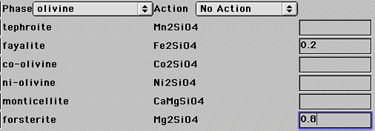Basic operations

- (2.1) Enter composition of the phase (in wt % oxides) in the left-hand column of text entry boxes. Note that entries may be left blank if data are unavailable for a particular oxide.
- (2.2) Select Wt% -> X from the Action popup menu.
- (2.3) The result of the calculation will be displayed in the right-hand column of text entry boxes. The displayed mole fractions represent a best estimate of component mole fractions consistent with the input composition.

- (3.1) Enter composition of the phase (in mole fraction of endmembers) in the right-hand column of text entry boxes as shown above for the phase olivine. Note that entries may be left blank if data are unavailable or if a subsystem is of interest.
- (3.2) Select X -> Wt% from the Action popup menu.
- (3.3) Result of the calculation will be displayed in the left-hand column of text entry boxes.
- (4.1) If the phase is not a solid solution go to step 4.3.
- (4.2) Enter composition of the phase (in mole fractions of endmembers) in the right-hand column of text entry boxes.
- (4.3) Enter temperature (in K) in the text box to the right of the label T (K).
- (4.4) Enter pressure (in bars) in the text box to the right of the label P (bars).
- (4.5) Select X -> Thermo from the Action popup menu.
- (4.6) Result of the calculation will be displayed in the output box in the lower half of the APPLET. If an error message is returned go this link for an explanation and course of action.

- (4.7) Note that the chemical potential (mu) includes a standard state contribution representing the apparent Gibbs free energy of formation of the endmember at T and P from the elements at 298.15 K and 1 bar. Both results for mu and activity (a) are not meaningful if the endmember mole fraction is zero. mu is the std state property for a pure phase.
Last Modified
